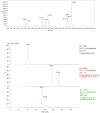Co-occurrence of the cyanotoxins BMAA, DABA and anatoxin-a in Nebraska reservoirs, fish, and aquatic plants
- PMID: 24476710
- PMCID: PMC3942747
- DOI: 10.3390/toxins6020488
Co-occurrence of the cyanotoxins BMAA, DABA and anatoxin-a in Nebraska reservoirs, fish, and aquatic plants
Abstract
Several groups of microorganisms are capable of producing toxins in aquatic environments. Cyanobacteria are prevalent blue green algae in freshwater systems, and many species produce cyanotoxins which include a variety of chemical irritants, hepatotoxins and neurotoxins. Production and occurrence of potent neurotoxic cyanotoxins β-N-methylamino-L-alanine (BMAA), 2,4-diaminobutyric acid dihydrochloride (DABA), and anatoxin-a are especially critical with environmental implications to public and animal health. Biomagnification, though not well understood in aquatic systems, is potentially relevant to both human and animal health effects. Because little is known regarding their presence in fresh water, we investigated the occurrence and potential for bioaccumulation of cyanotoxins in several Nebraska reservoirs. Collection and analysis of 387 environmental and biological samples (water, fish, and aquatic plant) provided a snapshot of their occurrence. A sensitive detection method was developed using solid phase extraction (SPE) in combination with high pressure liquid chromatography-fluorescence detection (HPLC/FD) with confirmation by liquid chromatography-tandem mass spectrometry (LC/MS/MS). HPLC/FD detection limits ranged from 5 to 7 µg/L and LC/MS/MS detection limits were <0.5 µg/L, while detection limits for biological samples were in the range of 0.8-3.2 ng/g depending on the matrix. Based on these methods, measurable levels of these neurotoxic compounds were detected in approximately 25% of the samples, with detections of BMAA in about 18.1%, DABA in 17.1%, and anatoxin-a in 11.9%.
Figures




References
-
- Rasmussen U., Johansson C. Diversity and specificity in cyanobacterial symbioses. Biol. Environ. 2002;102B:53–56.
-
- Bold H., Wynne M. Introduction to the Algae. 2nd ed. Prentice-Hall, Inc.; Englewood Cliffs, NJ, USA: 1985. p. 720.
-
- Mohammed Q. Master Thesis. King Abdul-Aziz University; Jeddah, Saudi Arabia: 2008. Effect of Blue-Green Algal Toxins on Ecological System.
-
- Chorus I., Bartram J. Toxic Cyanobacteria in Water: A Guide to Their Public Health Consequences, Monitoring and Management. Published on behalf of WHO, Taylor & Francis Group, Spon Press; London, UK: 1999.
Publication types
MeSH terms
Substances
LinkOut - more resources
Full Text Sources
Other Literature Sources

